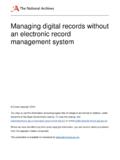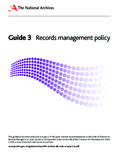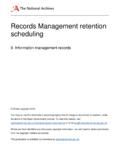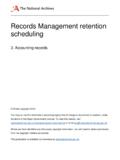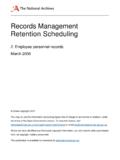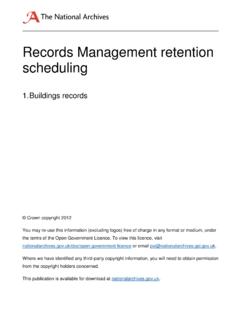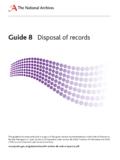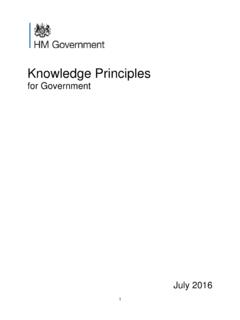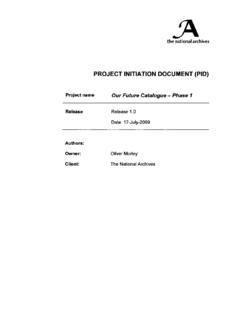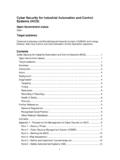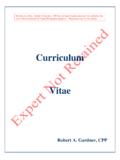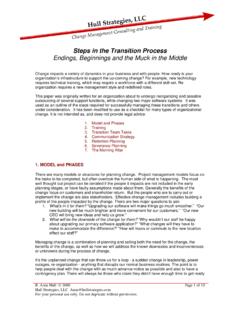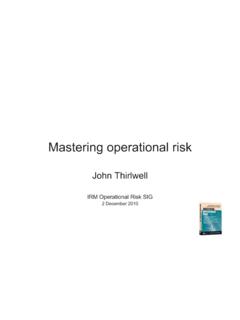Transcription of Archive Principles and Practice: an introduction to ...
1 Archive Principles and Practice: an introduction to archives for non-archivists Page 2 of 24 Crown copyright 2016 You may re-use this document (not including logos) free of charge in any format or medium, under the terms of the Open Government Licence. To view this licence, visit: ; or email: Any enquiries regarding the content of this document should be sent to Archives Sector Development: Page 3 of 24 CONTENTS 1. introduction What is the purpose of this guidance? Who is this guidance for? 2. Looking after archives What are archives? major risks Taking control Supporting safe access 3. Next Steps in archives Storage and preservation Records Management and Archives Cataloguing and Arrangement Funding and Sustainability Benefits from Your Archives Decisions on long term custody 4. Useful Information Other published guidance Audio-Visual Preservation Specialist advice Archival networks Professional Organisations and membership Training Courses and Professional Development Useful books 5.
2 Case Studies Case studies Page 4 of 24 1 introduction What is the purpose of this guidance? The purpose of this guide is to support people who own or look after Archive material. It will help you to assess and plan for the care and development of your Archive collection. It applies to all sizes of collection from a small storage cupboard to the contents of a large storeroom. The prospect of organising and developing your Archive can be daunting. If the process is divided into simple tasks, the process becomes much easier to manage. It is often easier to recognise that action is needed than to know where to start. 1 With this in mind, the guide includes practical steps, which can easily be taken to protect archival collections. Who is this guidance for? This guidance is mainly aimed at people who look after or own archives, but who are not professional archivists and need some simple guidance. It may also be useful for museum, library and other heritage professionals who have archives in their care and need guidance to improve what they can do.
3 How is this guidance arranged? The guide is organised into two main sections to provide a helpful level of detail for beginners, and more experienced professionals. For beginners, working through each section will build knowledge and allow you to work towards best practice with an understanding of the methods and support which is available. Section 2 is for beginners and has simple steps to improve what you are doing (or not doing) to better care for and provide access to your archival collections. It includes protection from the major risks of fire, flood and theft and is suitable for beginners and small organisations without a professional archivist. Section 3 is for more experienced custodians and shows how you can take additional steps to improve what you are doing, including more complex solutions to care for and protect your It is suitable for people with some knowledge and experience in small to medium sized organisations.
4 There are 2 supplementary sections with additional information and examples of good practice. Section 4 includes Useful Information for all who care for archives. Section 5 includes Case Studies describing good practice and progress made by others. 2. First steps in archives What are archives? Archives are collections of documents or records which have been selected for permanent preservation because of their value as evidence or as a source for historical or other research. Records are created by the activities of organisations and people; they serve an active purpose whilst in current use and some of them are later selected and preserved as part of an archival collection. 1 Managing the Preservation of Library and Archive Collections in Historic Buildings, National Preservation Office (2002) 2 A custodian is someone who keeps or looks after a collection.
5 It often describes someone in museum or gallery sectors. It is used here to describe someone who keeps or looks after an Archive collection. Page 5 of 24 Archive collections are usually unique, which is why it is so important to take proper care of them. They need to be carefully stored and managed to protect and preserve them for current and future use. Sometimes these collections are kept in specialist collecting institutions, which are also called archives . Examples of these include national and local archives and record offices. Archives are also kept by other institutions, including museums and libraries. Sometimes archival collections are kept in other locations such as religious organisations, universities, schools, businesses, charities, arts organisations and community groups that often hold their own institutional records. Why are archives important? Archives have value to nations and regions, organisations, communities, and individual people.
6 They provide evidence of activities which occurred in the past, they tell stories, document people and identity and are valuable sources of information for research. They are our recorded memory and form an important part of our community, cultural, official and unofficial history. major risks Risk cannot be avoided completely and even if you are well-prepared, events happen which can damage buildings and the archives stored in them. However, much can be done to manage these risks. The first thing to do is think of the things that can go wrong; then look at what steps you can take to prevent things going wrong; then plan what to do if despite your efforts things do go wrong and there is an incident of some sort. The major risks are fire, flood, theft and unauthorised access. Guidance on these is given at to below. An important tool to safeguard archival collections is a disaster management plan and guidance on this is given at below.
7 Fire prevention Fire prevention is the first line of defence in preventing destruction or irreversible damage to archives. Areas where archives are stored should be solidly built and must avoid the risk of fire. Storerooms should be assessed for risks from fire and suitable counter measures put in place. This includes fire-resistant doors, walls, ceilings, floors and windows. All of this is supported by the fire-prevention measures needed for any place of work or public building. What you can do Never use open fires, stoves, gas, radiant electric or paraffin heaters in an Archive building. The storage area should have fire-resistant doors, walls, ceilings, floors and windows. Most offices have twenty-minute fire resistant doors. Archives need more protection than this. The ideal would be four-hour fire resistant doors. Electric wiring circuits should be routed through metal conduits (tracking which holds the wires clear of other materials.)
8 Master switches for electrical circuits should be outside the storage area. Smoke detectors should be fitted inside and outside the storage area. Smoke detectors should link to the building s main alarm system and where possible, the Fire Service. Page 6 of 24 Flood Water will cause major damage to archives. Flooding can be caused by water coming into the building from outside or by water leaking from tanks or pipe work inside the building. What you can do If the building is in an area known to be at risk of flooding, archives should be stored on the first floor or above. Ideally, they should be relocated to another building less at risk. Shelving should be raised off the ground to avoid damage from minor flooding or leaks. Roofing, guttering and drains for rainwater should be in good condition and regularly checked and maintained to prevent water entering the building. Water tanks and pipe work inside the building should be in good condition and regularly checked and maintained to prevent leaks.
9 Pipe work should not run through storage areas. This includes all plumbing and central heating water pipes. Storage areas should not be directly below water tanks, boilers or pipe work. Basement storage should be avoided. Where used, it needs special attention to prevent flooding. If possible, it should not be near to storm drains or sewage pipes. Theft or unauthorised access Protecting archives from theft, deliberate damage or disorder ensures that they remain complete, intact and usable. Storage rooms, areas and cupboards must be lockable. Only the people responsible for caring for the archives should access these areas. Archives and current records need to be protected from unauthorised access. This means that people who should not have access to the records and the information they contain should be prevented from gaining access. Secure storage applies to all types of records: paper and parchment; digital records; video and sound recordings and any copies made of them.
10 Protecting archives and records in this way is sometimes called information security . What you can do Storage must be lockable and kept locked when not in use. Access to the storage area must be controlled and monitored. If storage areas have to be shared, archives should be clearly separated and only handled by people responsible for their care. No item should be moved or removed without the permission of those people responsible for their care. If an item is moved or removed, a note must be left with details of where it is and who has it. A register of withdrawals and returns should be kept. A separate area for viewing and using the archives should be set aside if possible. All areas should be monitored when in use. Disaster planning The impact of risks can be reduced by disaster management planning, for example arrangements for salvaging the Archive if a major incident such as a flood, a fire or a break-in happens.
